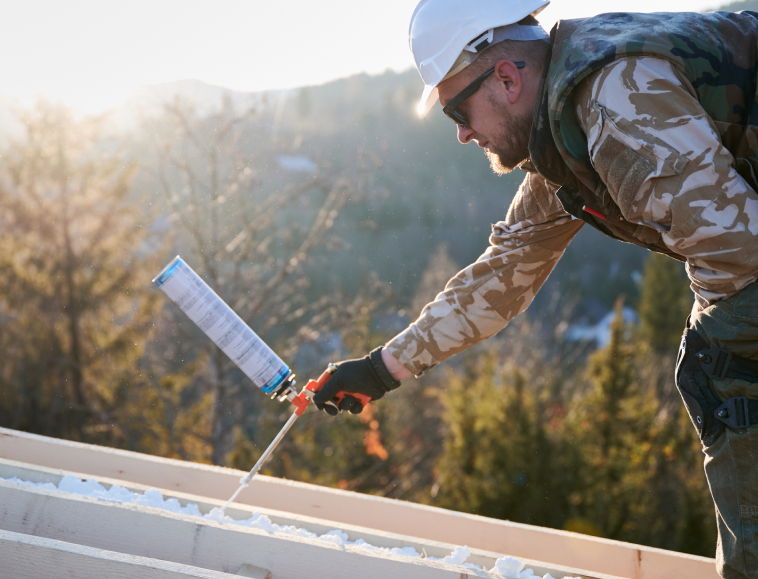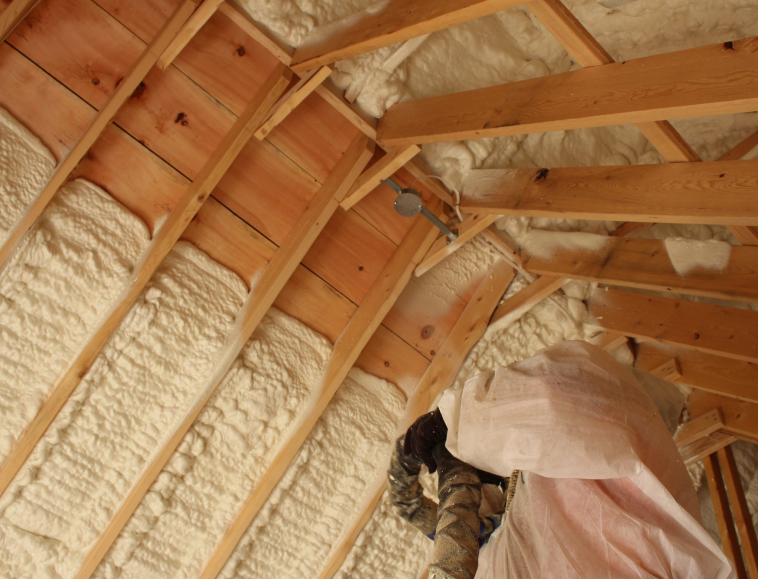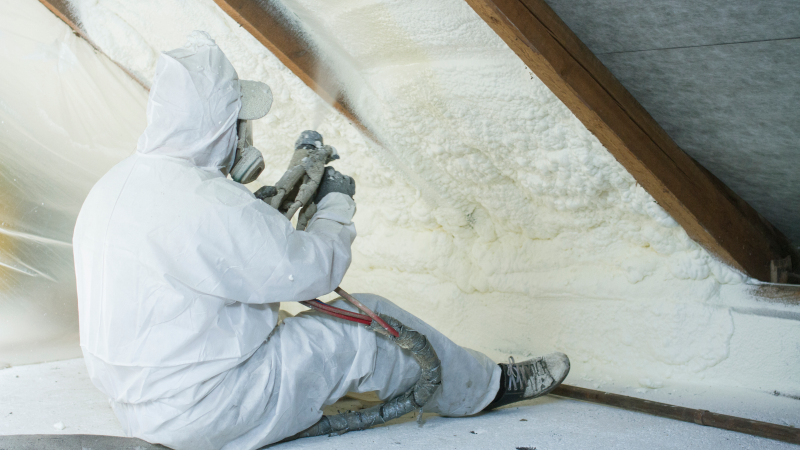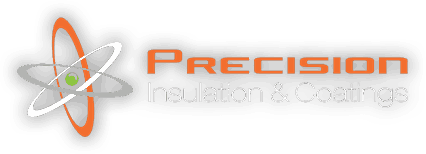Few upgrades offer as many advantages as spray foam insulation when it comes to improving your home’s comfort, efficiency, and value. At Ames Spray Foam Insulation, we deliver modern insulation solutions that outperform outdated materials like fiberglass and cellulose.
Whether dealing with high energy bills, uncomfortable drafts, or inconsistent temperatures, we provide a long-term, high-performance upgrade designed for Iowa’s harsh weather conditions.
In this blog, we’ll explore the benefits of spray foam insulation, how it works, how it compares to traditional fiberglass, and how to know when it’s time for a replacement. Let’s dive into why spray foam from Ames Spray Foam Insulation might just be the smartest investment you can make for your home.
What is Spray Foam Insulation?

Spray foam insulation is a liquid-applied material that expands into a dense foam when sprayed into walls, attics, crawl spaces, and other cavities. It creates an airtight seal that effectively blocks air, moisture, and even sound from penetrating your home.
There are two primary types of spray foam insulation:
- Open-cell spray foam: Lighter and less dense, perfect for interior walls and sound dampening.
- Closed-cell spray foam: Denser and more rigid, ideal for exterior applications and moisture resistance.
How Spray Foam Insulation Works
One of the biggest advantages of spray foam is how it works differently than traditional insulation. Instead of relying solely on trapping air like fiberglass or cellulose, spray foam expands upon application and fills every crack, gap, and seam. This creates a continuous thermal barrier, reducing heat transfer and stopping air leakage at the source.
Once cured, the foam becomes solid, providing both insulation and structural support. This dual-function makes spray foam incredibly effective in areas prone to drafts, moisture, or temperature swings.
Benefits of Spray Foam Insulation

Spray foam isn’t just another insulation option—it’s a comprehensive upgrade. Here are the top benefits of spray foam insulation for homeowners:
1. Superior Energy Efficiency
Because of its airtight seal, spray foam reduces energy loss through gaps and cracks. This means your HVAC system doesn’t have to work as hard to maintain your desired temperature. Energy savings with spray foam insulation can reduce heating and cooling costs by up to 50% annually in some cases.
2. Moisture and Mold Resistance
Unlike fiberglass, spray foam doesn’t absorb water. Closed-cell foam acts as a moisture barrier, helping prevent mold growth, rot, and structural damage—especially in humid or flood-prone areas.
3. Improved Indoor Air Quality
By sealing out dust, allergens, pollen, and even insects, spray foam can dramatically improve indoor air quality. This is especially beneficial for homes with allergy sufferers or respiratory concerns.
4. Increased Structural Strength
Closed-cell spray foam hardens into a solid material that can actually strengthen walls and roofs. It’s ideal for reinforcing older homes or areas subject to heavy winds.
5. Noise Reduction
Open-cell foam excels at absorbing sound. When used in walls or between floors, it reduces noise transfer, making your home quieter and more peaceful.
Spray Foam Insulation vs Fiberglass: What’s the Difference?
A common question among homeowners is how spray foam insulation vs fiberglass compares. Here’s a quick breakdown:
| Feature | Spray Foam | Fiberglass |
| R-Value per inch | High (up to R-6.5) | Moderate (R-2.2 to R-3.5) |
| Air sealing capability | Excellent (air-tight seal) | Poor (leaves gaps and air pockets) |
| Moisture resistance | Closed-cell is moisture-resistant | Absorbs water and prone to mold |
| Lifespan | 20–30+ years | 10–15 years |
| Installation method | Professional spray application | DIY-friendly batts or rolls |
| Initial cost | Higher upfront | Lower upfront cost |
| Long-term energy savings | Significant | Minimal |
While fiberglass has long been a go-to option, it simply can’t match the performance and longevity of spray foam. For homeowners serious about energy efficiency, spray foam is the clear winner.
Energy Savings with Spray Foam Insulation
The true power of spray foam insulation lies in its energy-saving capabilities. By creating a seamless thermal envelope, spray foam minimizes the energy needed to heat or cool your home.
According to the U.S. Department of Energy, air leakage accounts for 30% or more of a home’s heating and cooling costs. Spray foam dramatically reduces this number by sealing leaks better than any traditional material.
Over time, these energy savings with spray foam insulation can recoup the initial investment—often within 3 to 5 years.
Residential & Commercial Spray Foam Insulation in Ames
We proudly serve both homeowners and businesses. Our residential spray foam insulation in Ames is ideal for attics, walls, basements, crawlspaces, and garages.
Our commercial spray foam insulation in Ames is perfect for metal buildings, warehouses, retail stores, and office complexes seeking energy efficiency and code compliance.
Signs You Need New Insulation
Not sure if your current insulation is doing its job? Here are common signs you need new insulation:
- Uneven indoor temperatures – Hot and cold spots can mean air is escaping.
- High utility bills – Poor insulation forces HVAC systems to work overtime.
- Drafts or cold floors – Especially near windows, doors, or attics.
- Pest infestations – Rodents and insects often nest in worn-out fiberglass.
- Mold or mildew smell – Water-soaked insulation breeds mold.
- Old age – Fiberglass insulation loses effectiveness after 10–15 years.
If any of these sound familiar, it may be time to consider upgrading to spray foam.
Where Spray Foam Insulation Makes the Most Impact
Spray foam can be installed almost anywhere, but certain areas yield the best return on investment:
- Attics: Prevents rising heat loss and reduces HVAC load.
- Basements and crawl spaces: Blocks ground moisture and cold air.
- Exterior walls: Creates a true building envelope.
- Garages and bonus rooms: Keeps these semi-conditioned spaces comfortable year-round.

Is Spray Foam Insulation Worth the Cost?
While spray foam has a higher upfront cost than fiberglass, it pays off in energy savings, durability, and performance.
Homeowners can expect:
- Up to 50% lower energy bills
- A healthier indoor environment
- Fewer repairs over time
- An increase in resale value
Not to mention, many state and federal programs offer energy efficiency rebates or tax incentives for spray foam installations.
Professional Installation Matters
Certified professionals must install Spray foam insulation to ensure proper application and safety. An experienced team will:
- Identify key air leakage zones
- Use the right type (open-cell vs closed-cell) for your needs
- Maintain proper thickness and curing times
- Handle ventilation and protective measures
Hiring a qualified contractor ensures you get the full value and performance that spray foam offers.
Make the Smart Upgrade Today
If you’re considering an insulation upgrade, now is the perfect time to switch to spray foam. Ames Spray Foam Insulation delivers unmatched performance, energy savings, and indoor comfort you can feel.
Considering all the benefits of spray foam insulation—from lowering your energy bills and improving comfort to reducing moisture problems and boosting your home’s value—it’s clear why this upgrade from Ames Spray Foam Insulation is a smart move.
Whether you’re replacing outdated fiberglass or insulating a new build, spray foam offers unmatched performance that lasts for decades.So, if you’re noticing signs you need new insulation, or you’re simply ready for a smarter, more energy-efficient home, now is the perfect time to consider spray foam insulation. It’s more than just a home improvement—it’s an investment in comfort, health, and long-term savings.
If you’re considering an insulation upgrade, now is the perfect time to switch to spray foam. We deliver unmatched performance, energy savings, and indoor comfort you can feel. Contact us today to learn more about our spray foam insulation installers in Ames or to schedule a no-obligation energy audit.


